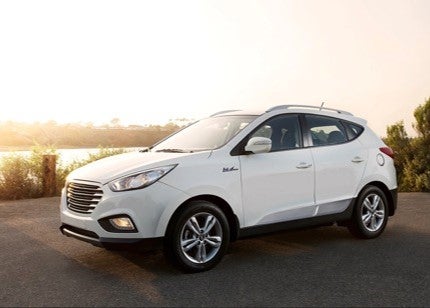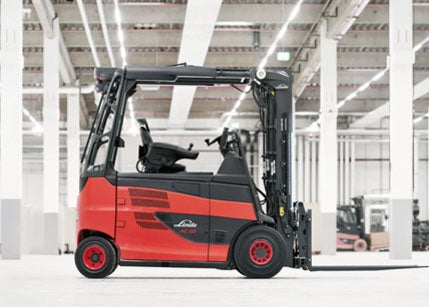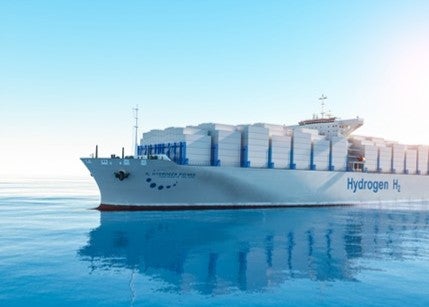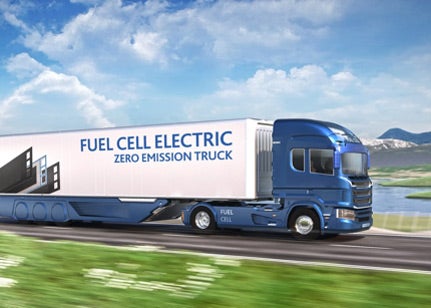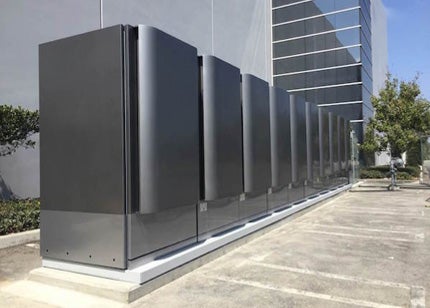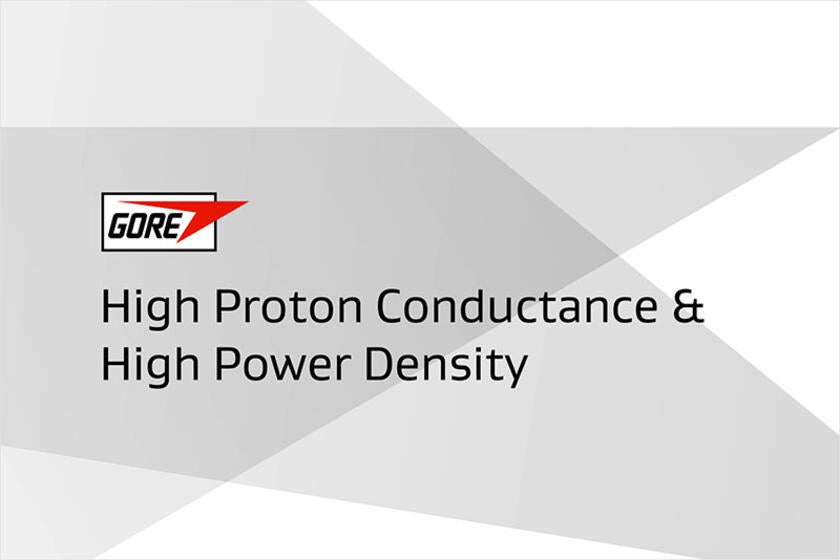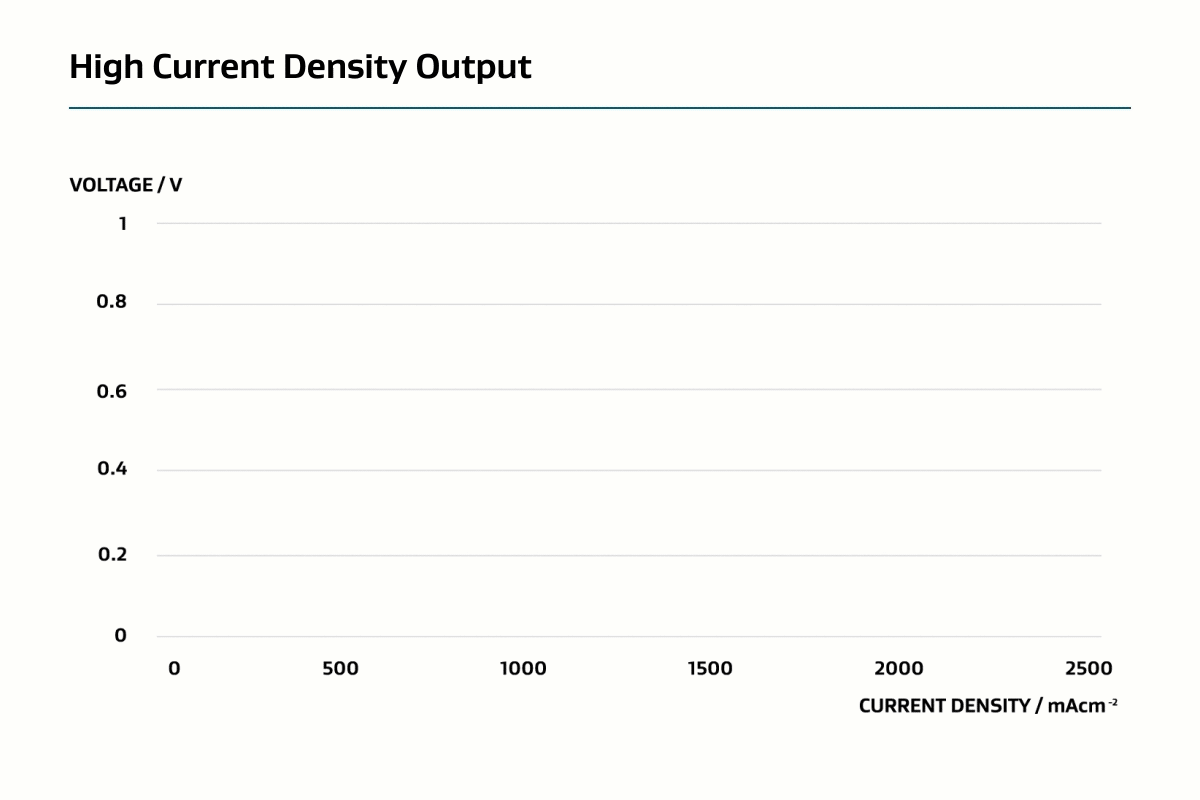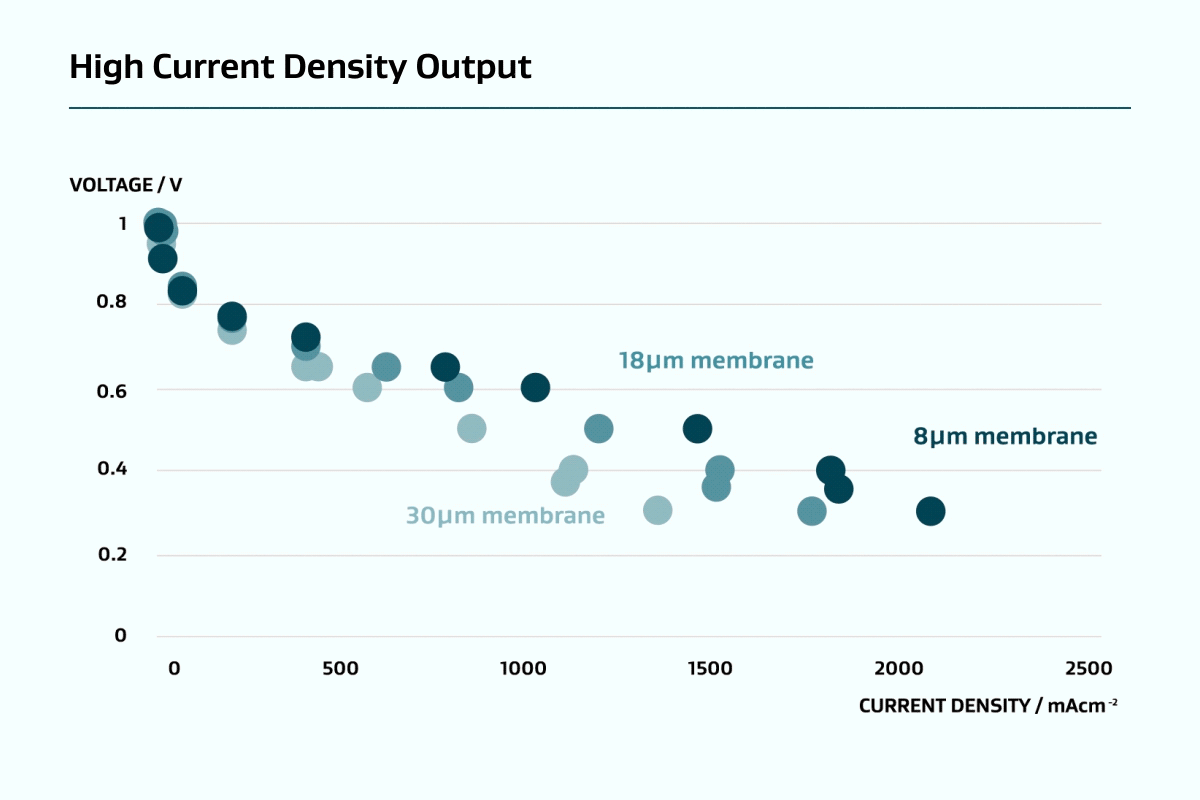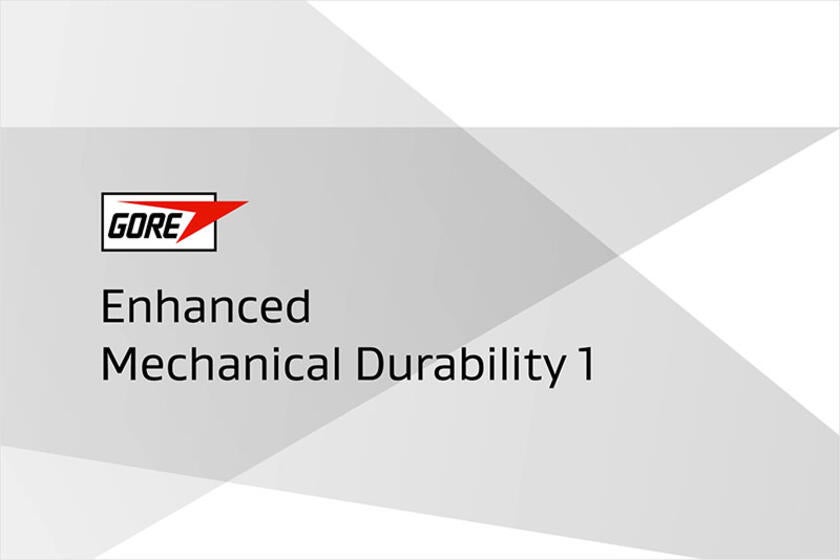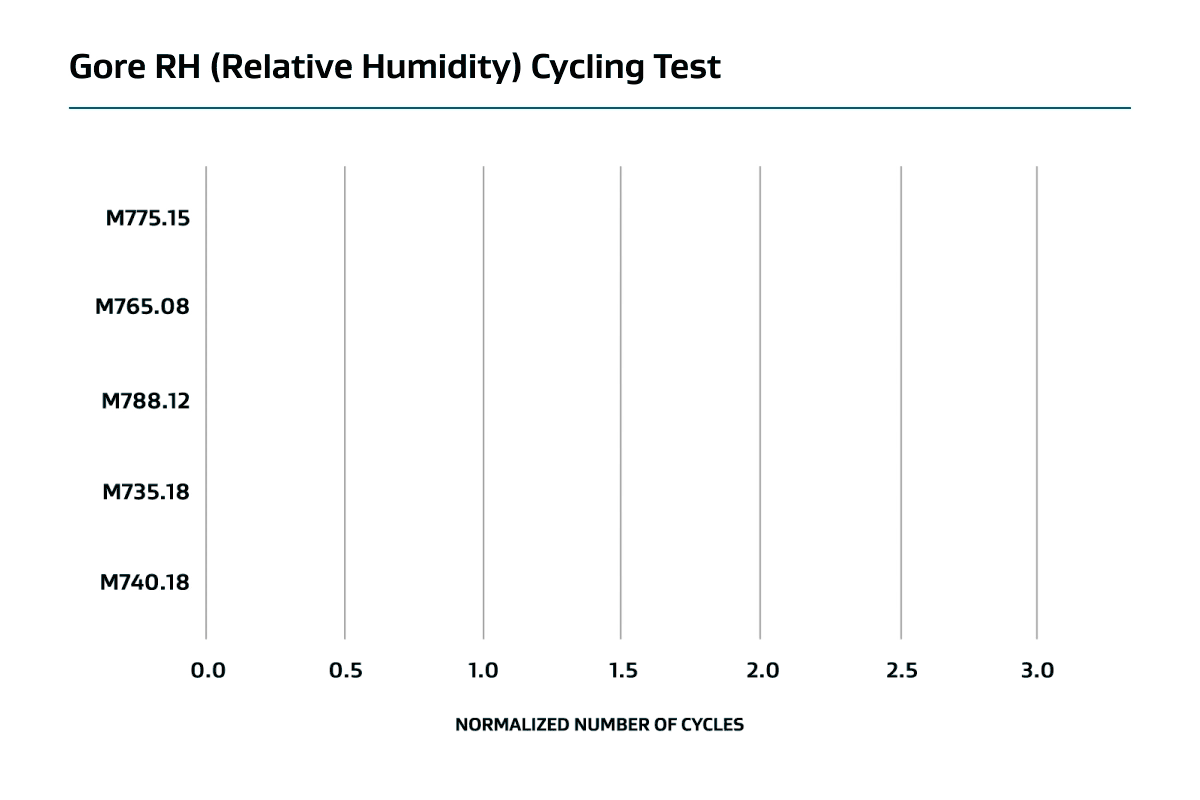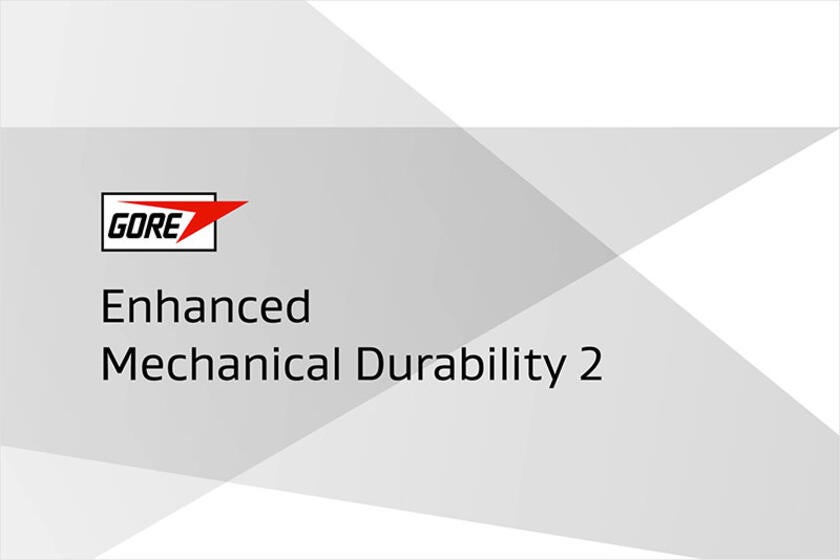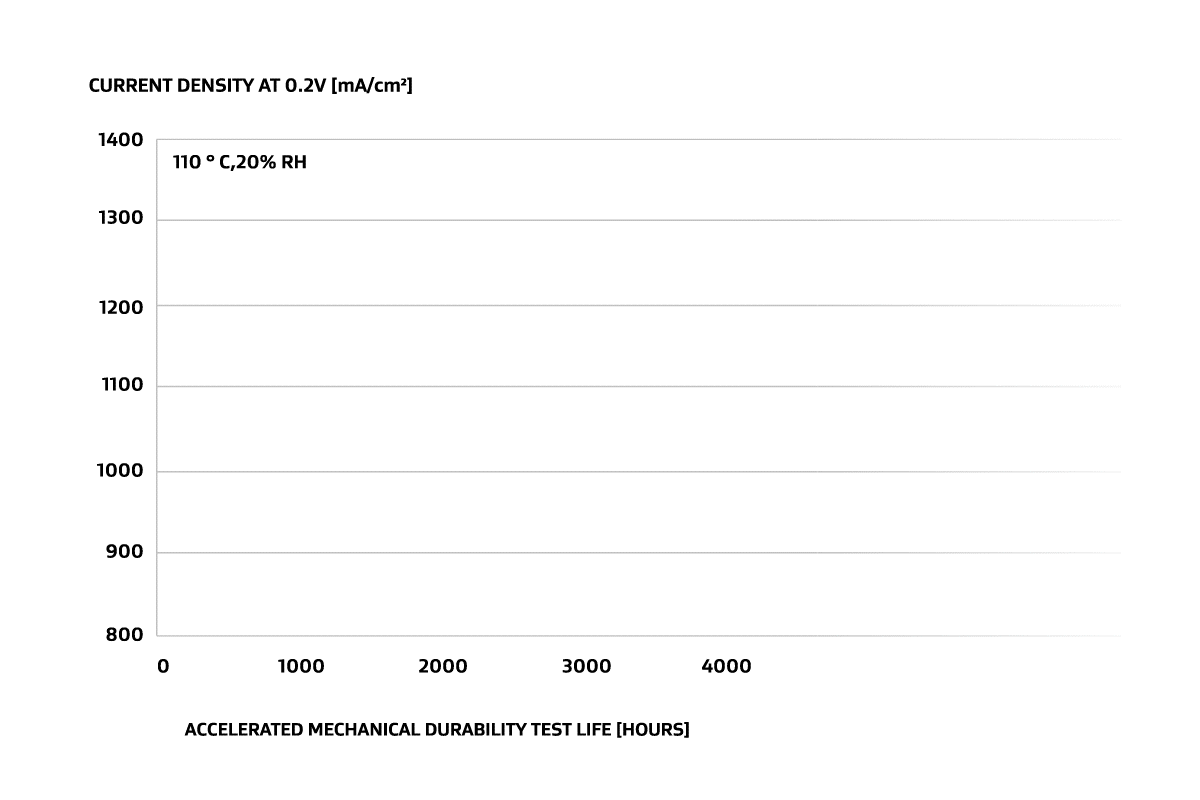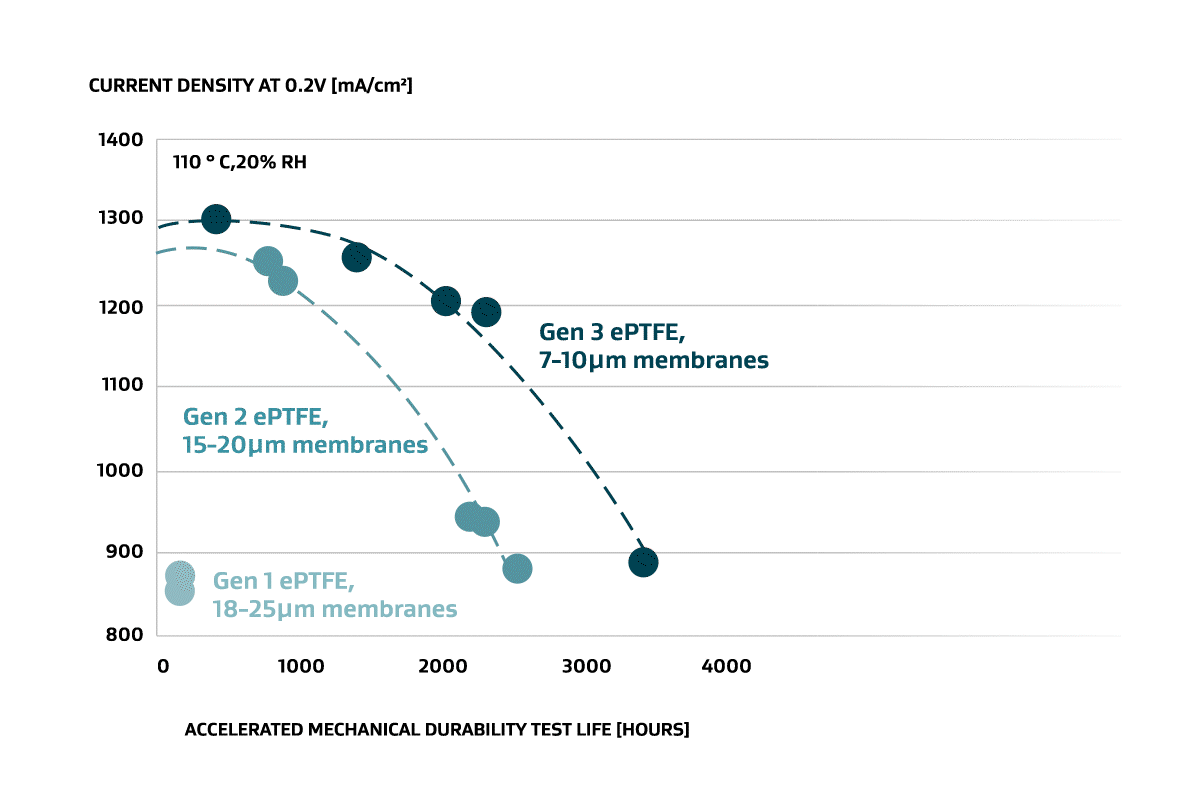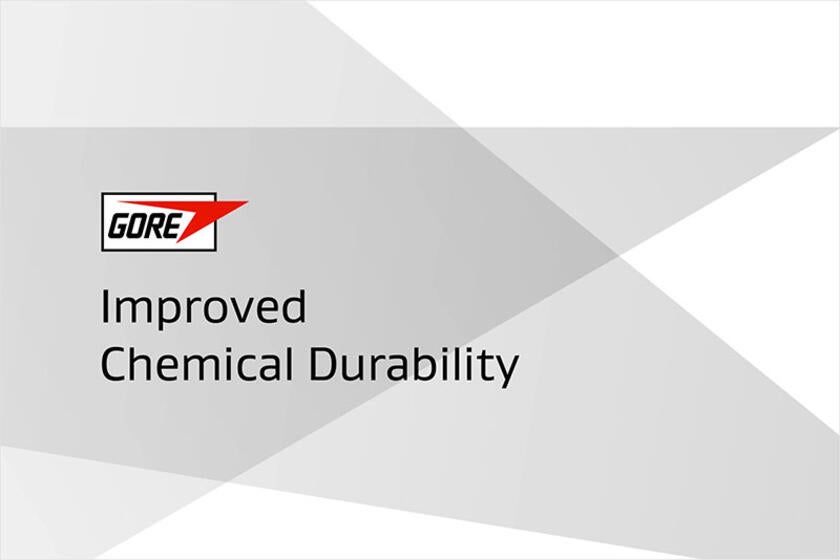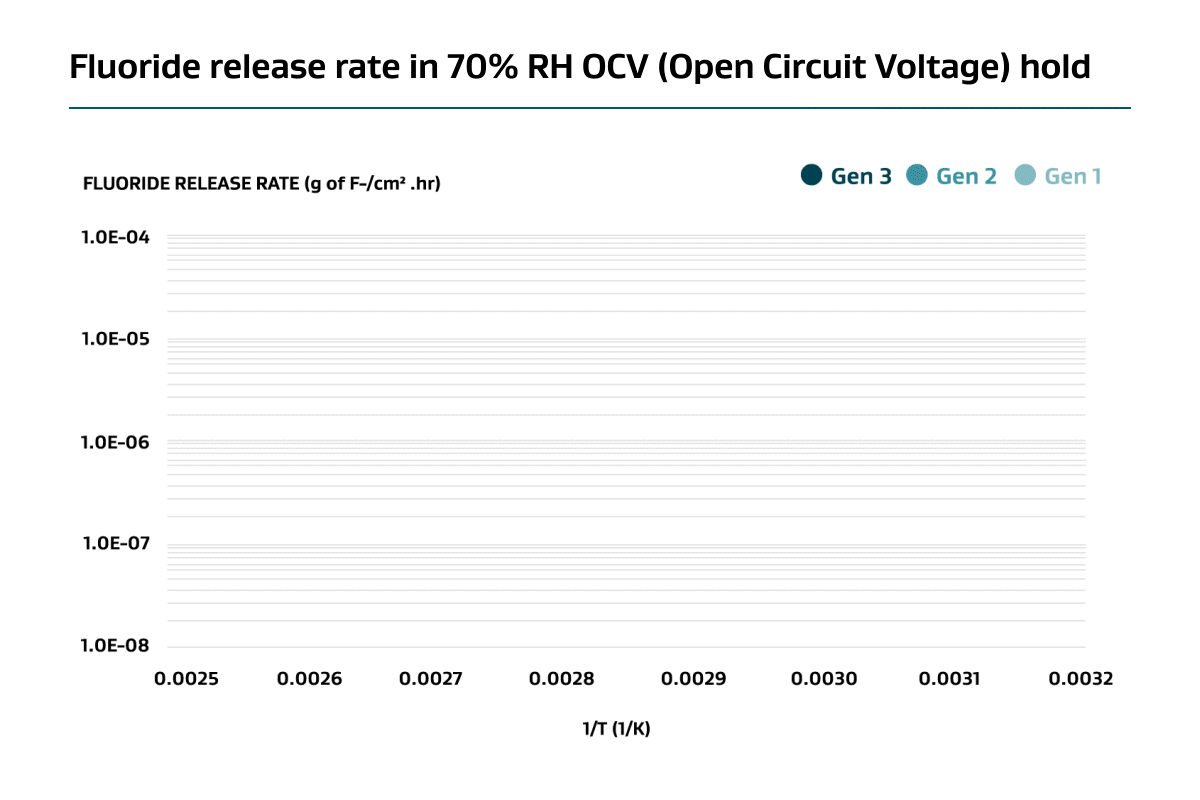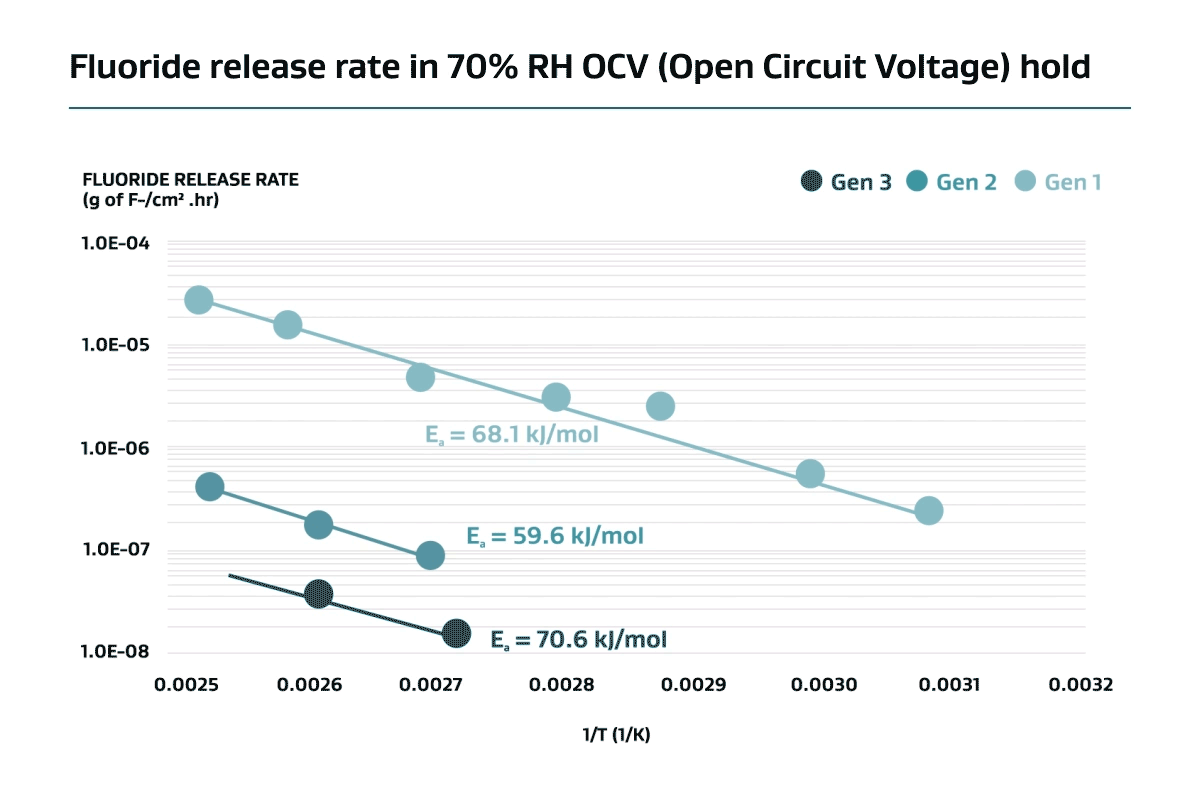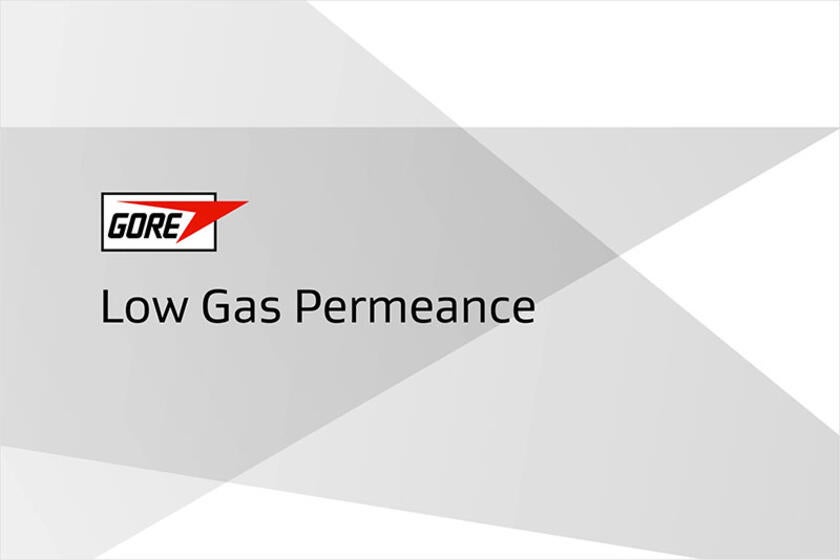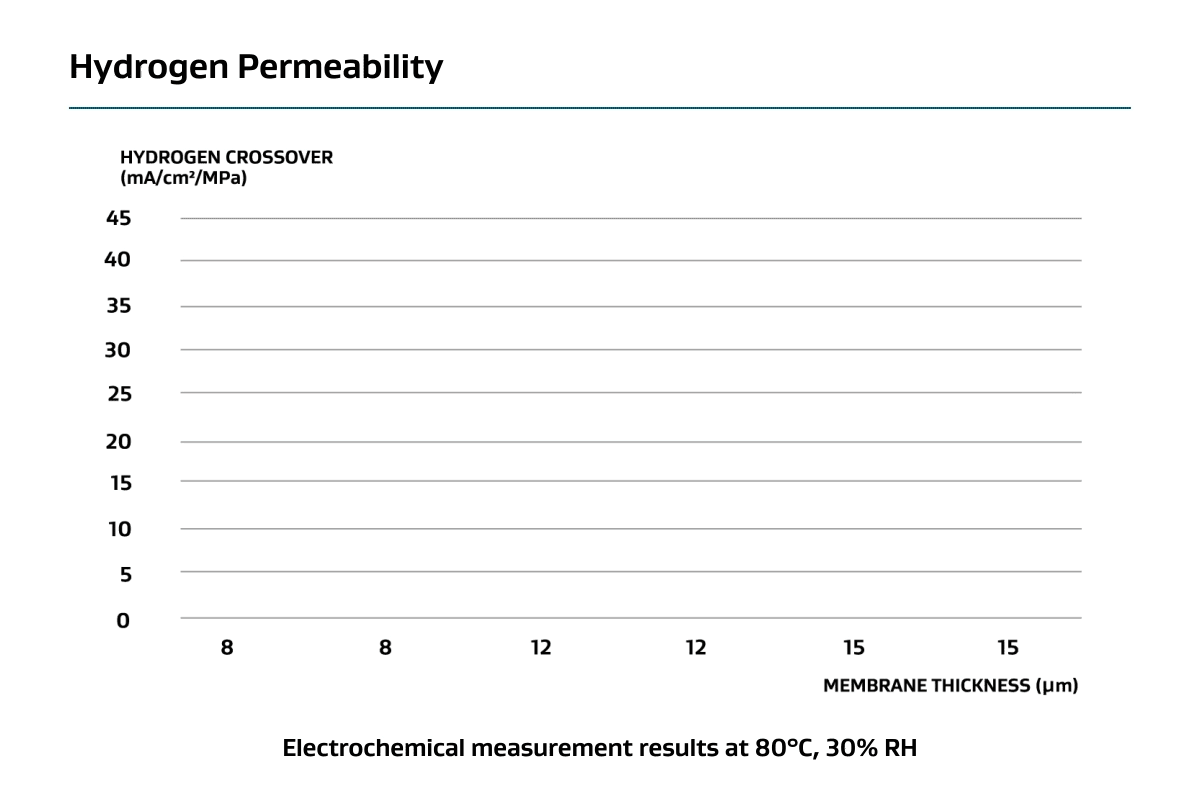Overview
CREATING SUSTAINABLE ENERGY SOLUTIONS TO POWER OUR FUTURE
The world’s energy demands are growing – and so are its environmental concerns.
From the individual to the industrial level, we all have a responsibility to commit to cleaner, more sustainable energy sources to ensure we protect our planet, our resources, and our people.
Gore’s mission is to develop impactful, sustainable and practical solutions that lower total cost of ownership with a long-term approach.
Our industry-leading proprietary Proton Exchange Membranes (PEM) and Membrane Electrode Assemblies (MEA) enable large-scale hydrogen fuel cell commercialization throughout major industrial market sectors, from stationary power generation to global long-haul transportation.
 |
"As hydrogen continues to gain global acceptance as a critical enabler to the energy transition and decarbonization, Gore remains relentless in our commitment to continuous innovation, pushing performance boundaries, addressing some of the most significant technical and economic industry challenges, and partnering to accelerate change across the hydrogen ecosystem. " Michelle Augustine, Gore Clean Energy Business Group Leader |
THE WORLD’S LEADING FUEL CELL TECHNOLOGY PORTFOLIO
GORE-SELECT® Membrane is a Proton Exchange Membrane (PEM). Within the fuel cell, the PEM separates hydrogen and air (oxygen), and transports protons from the anode to the cathode. These functions make the fuel cell PEM one of the most important determinants of fuel cell stack performance and service life.
To function reliably in an automotive fuel cell stack, the PEM must provide high proton conductance and high mechanical/chemical durability under repeated dry-wet cycles and harsh chemical conditions.
GORE-SELECT Membrane is a real drive-evaluated technology with a solid track record derived from iterative product innovation, testing and evaluation in zero-emission cars. Further innovations are already in development, to address the challenges that face the fuel cell vehicles (FCVs) of the future.
Our product line includes:
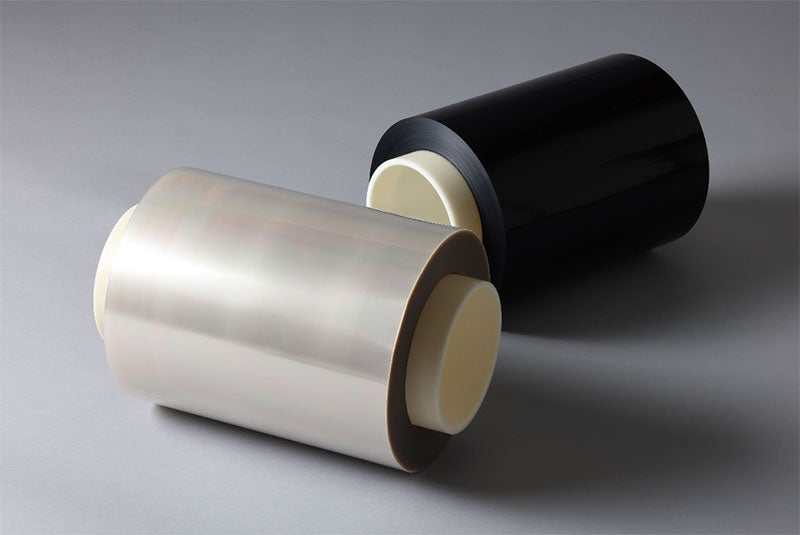
GORE-SELECT® Membrane
Enabling high output and long durability.
Based on our expertise in ePTFE reinforced composite membrane technology, GORE-SELECT® Membranes enable high output and minimum energy losses at the heart of the PEM fuel cell’s ion exchange membrane.
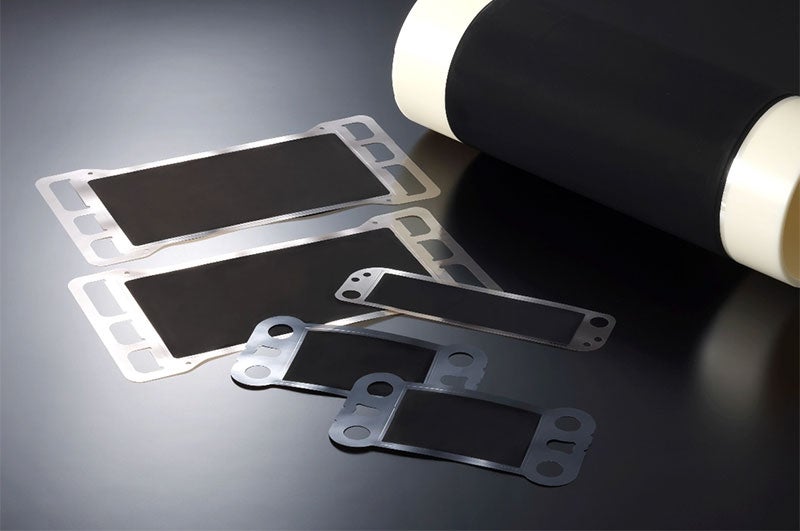
GORE® PRIMEA® Membrane Electrode Assemblies (MEA)
Powering our PEM fuel cells.
Gore's proprietary Membrane Electrode Assembly (MEA) is a central component of the PEM fuel cell. An MEA consists of the GORE-SELECT® Membrane with the Gore’s electrodes added on either side to facilitate the efficient electrochemical conversion of fuel to electrical energy.
GORE® Fuel Cell Technologies: Empowering Better Futures, Together
We understand our customer’s needs. We anticipate their requirements. And we exceed their expectations.
Gore Fuel Cell components are powering a wide variety of fuel cell systems in multiple applications and industries - and being used by nearly all major system developers worldwide.
Our GORE-SELECT® membrane addresses several key requirements of fuel cell manufacturers:
Exceptional Performance
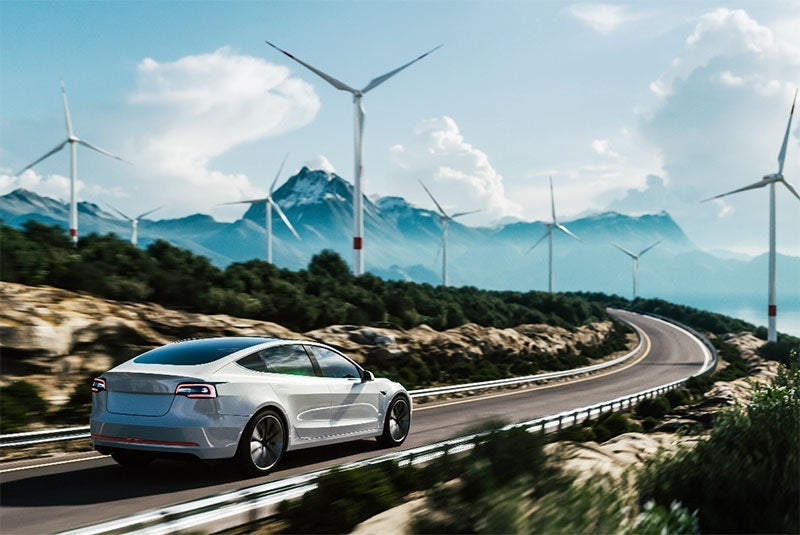
An ePTFE-reinforced GORE-SELECT® Membrane reduces the trade-off between power density, durability, and gas crossover, with a thinner design that demonstrates higher performance outputs that last longer – even in extreme conditions.
Our unique PEM design mitigates mechanical degradation. Our advanced additive technology compensates for chemical contamination.
A future-proof fuel cell technology, based on decades of development, testing and application.
Product Reliability
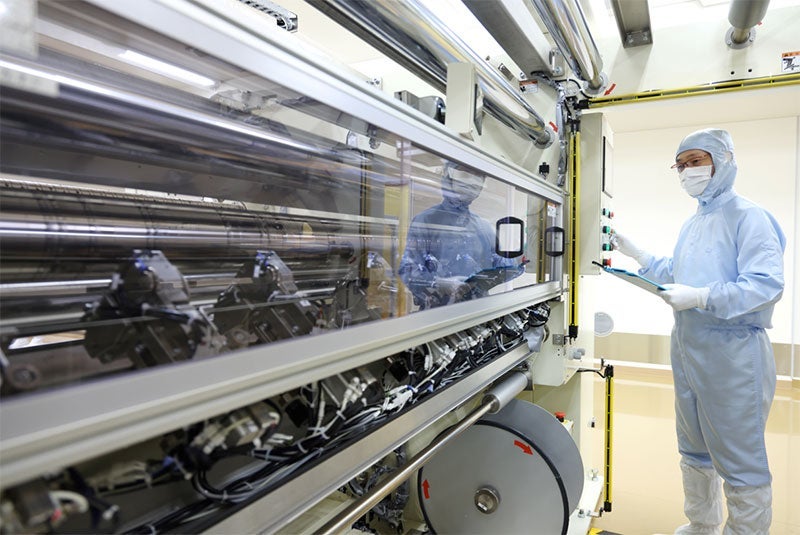
Reliability and quality. Broad words, relative concepts. One thing is clear: as we move towards mass-market adoption of fuel cell technology, we need a consistent supply of high-performing products to support it.
Gore’s mass production output demonstrates a product uniformity that gives manufacturers more control and less variability in their process – reducing risks of low yields and product failure.
Our expertise and capability in PEM design modeling can support customers who wish to accelerate their development timelines.
Our global capacity and proven track record have established a reliable and secure raw material supply chain, vertically integrated into our product divisions.
Lower Total Cost of Ownership

To be a truly sustainable energy solution, it’s not enough to be carbon-free. Hydrogen fuel cell technology has to be commercially viable, too.
Cost reduction strategies are essential to achieve economies of scale through high production volume.
A GORE-SELECT membrane reduces total cost of ownership across multiple categories. A lighter, thinner design enables greater manufacturing output with a given raw material supply. Its unique properties extend the life of the fuel cell stack, decrease lifetime system costs, and support a wider operating range for multiple applications.
From product performance to technical and engineering support, from quality consistency to supply security, see why Gore has the competitive advantage when it comes to commercializing fuel cell components.
From product performance to technical and engineering support, from quality consistency to supply security, see why Gore has the competitive advantage when it comes to commercializing fuel cell components.
Gore’s Fuel Cell Applications: Limitless Potential
From electric vehicles to entire industries - we’re changing the world.
Our vision includes not only hydrogen fuel cell engines in passenger and commercial vehicles, but also various types of clean energy and stationary applications such as residential fuel cells.

Every market has its own unique application requirements. Our ongoing development efforts keep us ahead of the technology curve, while our high-volume manufacturing capacity enables us to provide consistent, reliable performance to help our customers reach commercialization.
We’ve pioneered fuel cell industry developments since 1994. See how we’re transforming the automotive industry here.
Learn More >
GORE’S GLOBAL NETWORK
A World of Opportunity
Gore's global network of 28 sales offices (5 dedicated Alternative Energy & Storage sales offices in Germany, China, Korea, US, Japan), 2 research and development facilities, and 1 world-class manufacturing plant allows us to deliver what we promise for our customers and end consumers.
|
28 Sales offices across the globe |
2 Fuel cell R&D facilities in US & Japan |
1 Fuel cell manufacturing plant in Okayama, Japan |

Driving the Future
HYDROGEN ENERGY: IN THE DRIVER’S SEAT
Powering a wide variety of fuel cell applications in transportation, stationary, material handling, and portable applications worldwide.
The global transportation industry is a key player in the global commitment to cleaner energy. From passenger cars to commercial vehicles to long-range logistics, the entire mobility sector represents a massive opportunity for the fuel cell industry.
Fuel cell electric vehicles (FCEVs) offer an uncompromised driving experience – smooth, silent and responsive, with greater driving range and quicker refueling than other electric or zero-emission vehicles. In fact, FCEV driving range and fueling rates are comparable to conventional internal combustion engine (ICE) vehicles – without doing any damage to the air that we breathe.
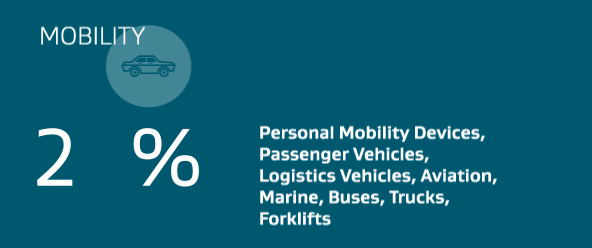 |
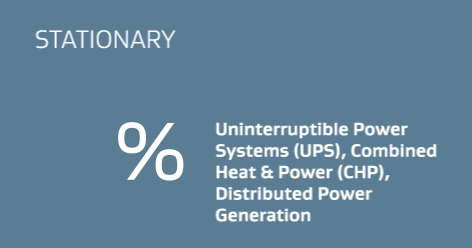 |
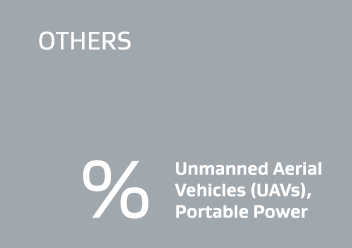 |
Traditionally carbon-heavy transportation sectors such as trucking, shipping and aviation are welcoming the potential of fuel cell technology, as it continues to evolve to support high-intensity, heavy-duty use.
Hydrogen fuel cells are an increasingly viable and cost-effective low-to-zero emission solution. As the scale of hydrogen energy deployment increases in line with global investment, reducing the cost of PEM production and associated technology, hydrogen fuel could be the most competitive low-carbon solution in multiple commercial and industrial applications by 2030. Improvements in PEM fuel cell efficiency will only accelerate the process.
ADVANCING THE AUTOMOTIVE INDUSTRY
We began developing our fuel cell components in the 1990s and have pioneered new developments at the forefront of the global fuel cell industry since then.
Today, we provide proprietary proton exchange membranes to the automotive industry: the only PEM manufacturer integrated into commercialized fuel cell electric vehicle production in the world.
Our advanced GORE-SELECT® brand fuel cell PEM technology played a critical role in the development of the world’s first mass-produced hydrogen fuel cell vehicle.
Our technology is quite literally at the heart of the FCEV movement: the essential component at the core of the PEM fuel cell stack.
And with the fuel cell vehicle market projected to produce an estimated half a million zero-emission vehicles annually by 2030, our PEM will be at the heart of a revolution.
Membrane Technology Advancing Fuel Cell Commercialization
Fuel cell technology is the key to a low-carbon, environmentally friendly transportation system. Proton exchange membranes (PEMs) are being successfully deployed in fuel cell stacks for passenger vehicles and are rapidly evolving into commercial applications.
Find out how Gore's materials engineering expertise and capabilities can accelerate the commercialization of FCEVs by dramatically improving the performance and reliability of fuel cell stacks and systems.

PEM technology helping reduce Total Cost of Ownership
Proton exchange membrane (PEM) fuel cells are among the most efficient, low-emission, low-temperature, and compact energy conversion technologies available today. Reducing the cost of PEM fuel cell systems is a critical factor in their economic viability in the fight against climate change.
Explore how PEM technology can help reduce commercial fuel cell vehicle production and maintenance costs, increase power output, and improve fuel efficiency to minimize the total cost of ownership (TCO).
We set industry standards. We win industry awards. We supply industry leaders. Our fuel cell journey began in 1994 and we’re just getting started.
GROWTH OPPORTUNITIES ACROSS THE ENTIRE AUTOMOTIVE INDUSTRY
The global fuel cell transportation market is set for exponential growth, and Gore is in the fast lane of opportunity. There are many emerging trends to capitalize on:
Accelerated Automotive Electrification
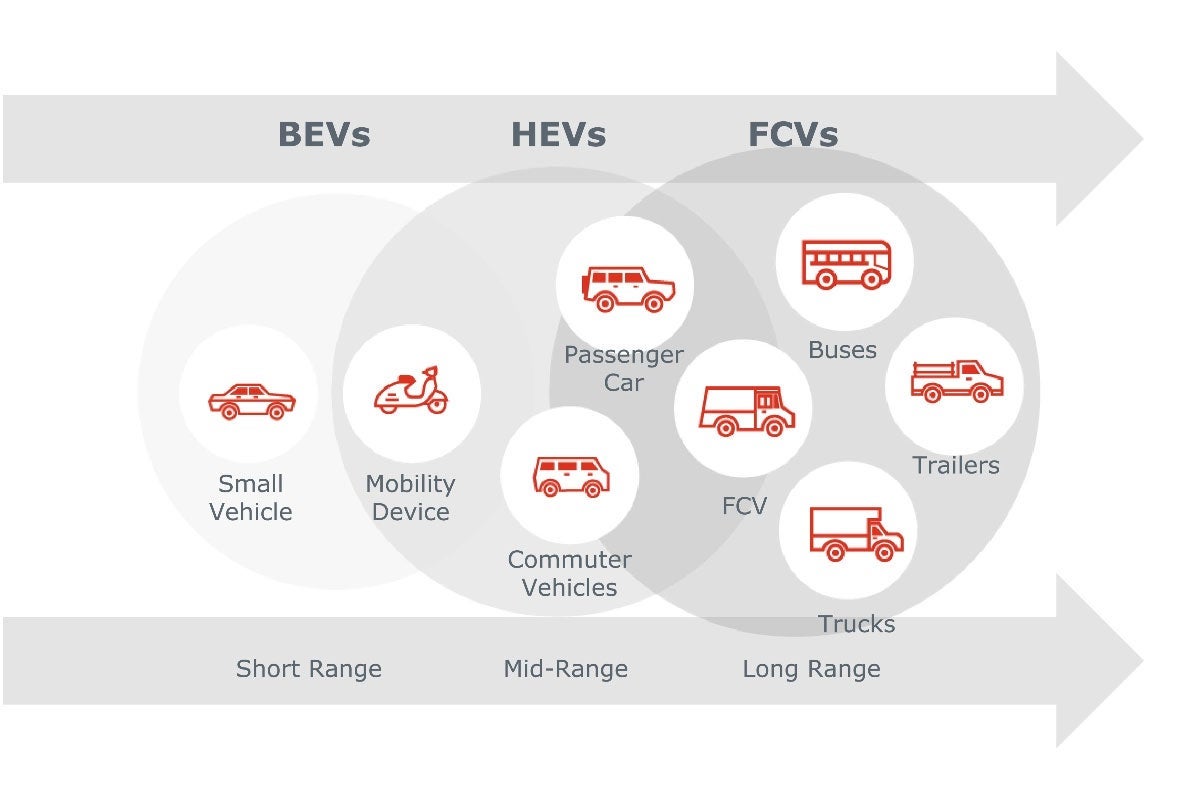
The advantages of hydrogen fuel cell cars include an electrified powertrain solution that supports fast refueling and longer-range transportation options. Both governments and private enterprises are not only increasing investment in electric passenger vehicle production, but also replacing existing fleets of commercial vehicles using internal combustion engines with large fleets of electrified vehicles.
Improved Hydrogen Ecosystem
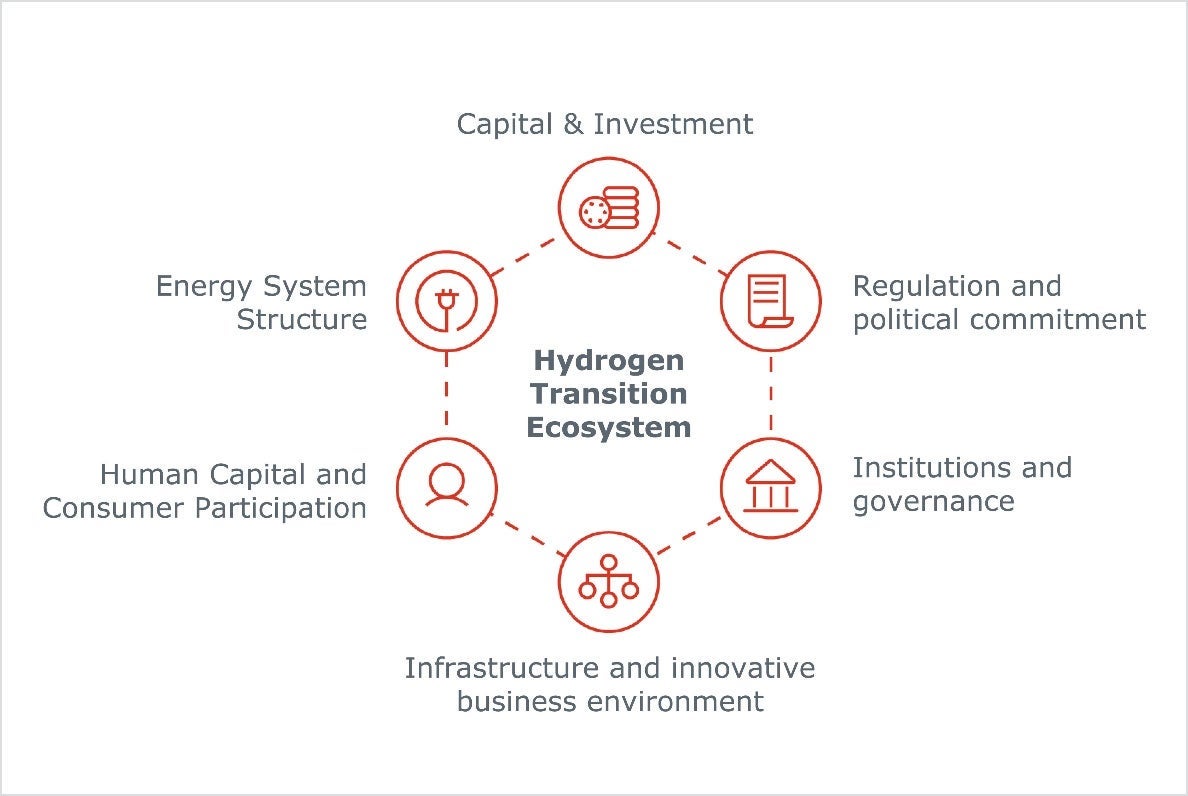
From investment to deployment, there is increased global interest in policies and regulation, infrastructure, and financial backing in the hydrogen ecosystem.
Over 30 countries have developed hydrogen energy roadmaps and set public commitments to low-carbon targets. Hundreds of large-scale hydrogen projects have been announced across the entire industry value chain. Public and private funding into hydrogen energy projects is set to reach over $300 billion by 2030.
Expanded Applications
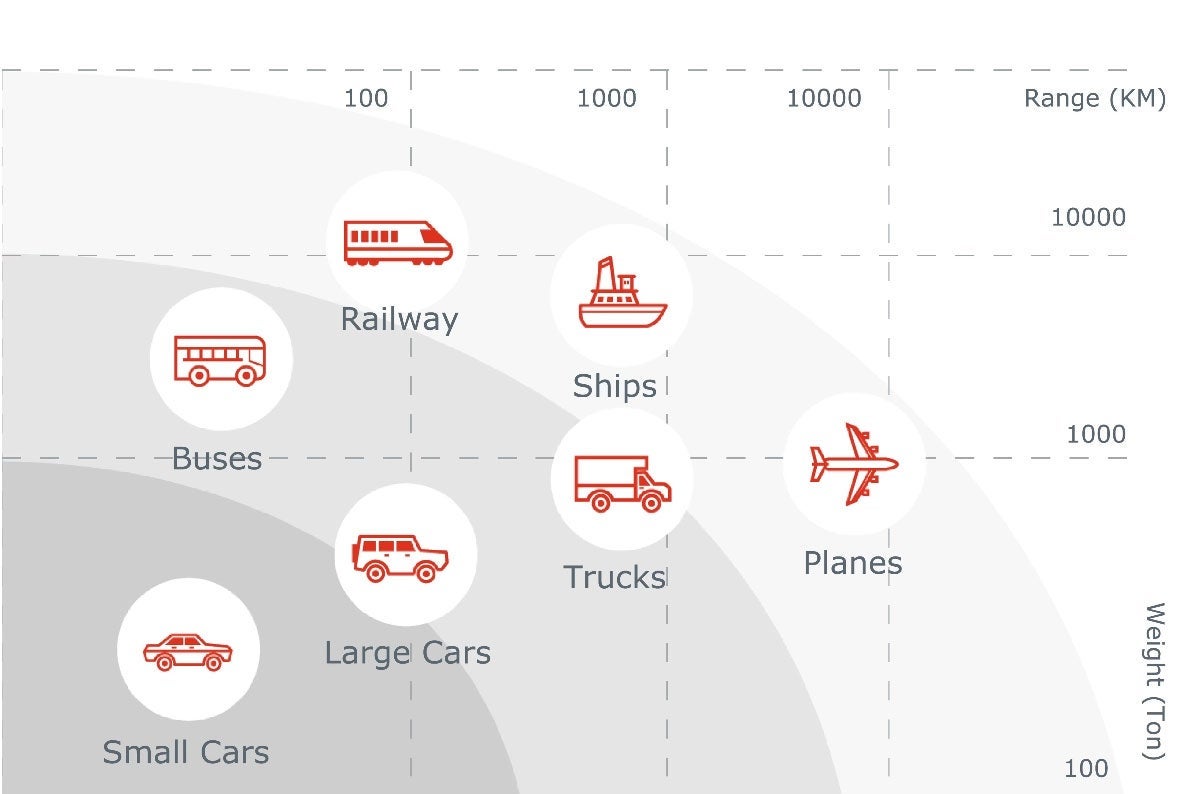
Fuel cell technology is expanding beyond the automotive industry into multiple sectors, including aviation, rail, and marine transportation, as well as utility vehicles and even scooters and bicycles.
From fuel cell buses, trucks that help reduce traffic pollution in major cities, to zero-emission vehicles that can be safely used indoors, the opportunities are endless to implement sustainable operations within commercial and industrial markets.
Cost Competitiveness
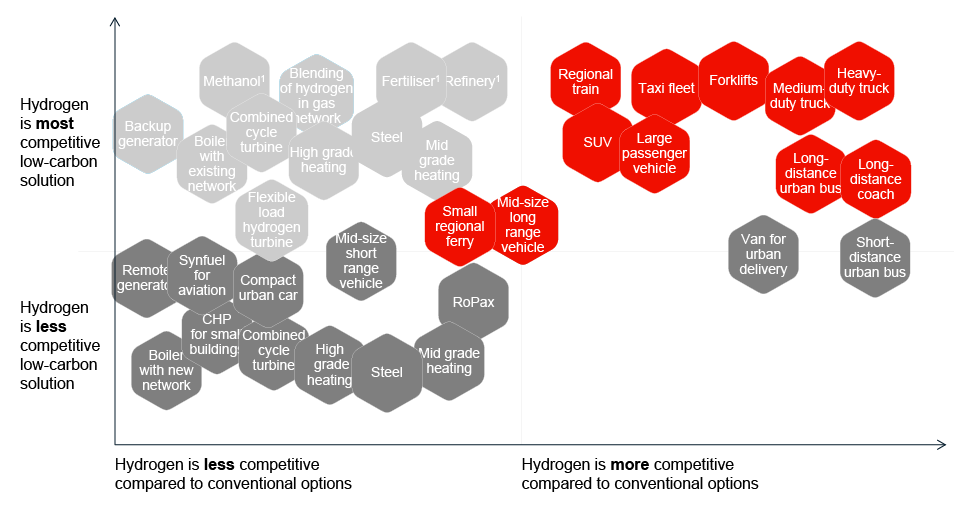
Through increased investment, international collaboration and partnerships, and increased global demand, the cost of fuel cell technology is expected to achieve cost parity with low-carbon and conventional fuel sources much sooner than expected.
Cost reductions in hydrogen production, transportation and integration will trigger increased investment in large-scale application and distribution networks to achieve a lower total cost of ownership across the entire global transportation industry.
FACING THE CHALLENGES IN THE FUEL CELL AUTOMOTIVE INDUSTRY
From innovation to implementation, cost management to commercialization, we are addressing four key areas in fuel cell development:
#1: Continuous Innovation
 |
In order to meet the needs of the rapidly accelerating trend of automotive electrification, we have developed more durable fuel cell technology that can offer higher levels of performance at a greater commercial scale. |
#2: Insufficient technical service and support for customer research and development
 |
As a new energy technology, and despite significant growing interest, fuel cell systems require greater support throughout both the development and commercialization cycle. Customers and suppliers must be able to understand research and development objectives, facilitate application and process knowledge sharing, and enable risk mitigation to provide customized, fit-for-use products and solutions. Increased testing, analysis and experimentation are required to develop fuel cell technologies that can achieve greater energy market penetration. |
#3: Cost parity with conventional and other low-carbon solutions
 |
As massive progress is made in the fuel cell industry, the energy market remains ultra-competitive as traditional and alternative options continue to develop. |
#4: Global supply security and quality consistency
 |
Suppliers must have the necessary facilities, systems and processes in place to meet mass production needs without compromising quality. From raw materials to end products, the global supply chain must be able to deliver cost-effective and reliable logistics solutions in multiple locations. |
GORE’S APPROACH
A global energy transition needs advanced technology. Many automotive manufacturers are turning to hydrogen-based fuel cell technology and electric vehicles in their efforts towards greater environmental responsibility - and this is where our expertise comes in.
Companies need a partner who understands the fuel cell industry and its vast potential - as well as how to navigate the various challenges involved in tapping into this potential.
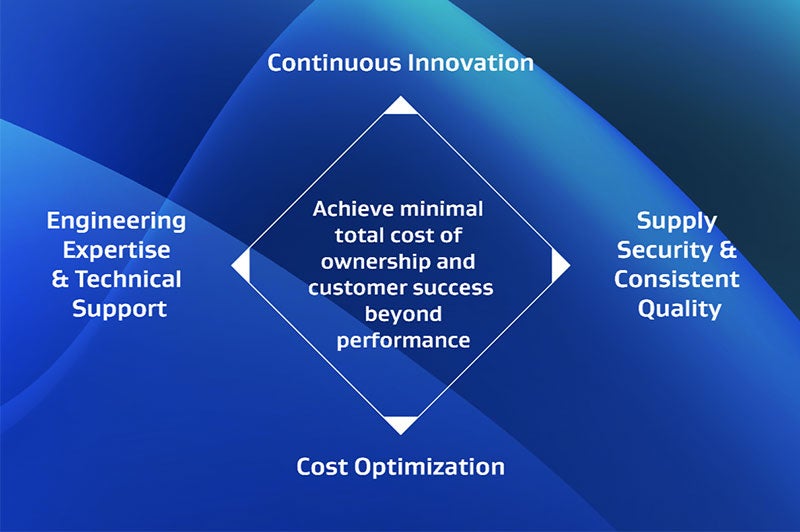
We enable our customers to achieve commercial success by constantly addressing four key challenges.
Our Products
GORE® FUEL CELL TECHNOLOGIES
Empowering a better future together.
In 1969, Bob Gore invented a remarkably versatile new polymer: expanded polytetrafluoroethylene, or ePTFE.
Today, ePTFE-reinforced GORE-SELECT® Membranes are considered the industry standard for challenging fuel cell applications.
Fuel cell power is one of the key enabler technologies in the hydrogen ecosystem, which is a significant contributor in the global transition to clean energy.
Since entering the fuel cell industry in 1994, Gore’s membranes have been proven in energy-efficient vehicles from leading OEMs, as well as in thousands of transportation, portable, and stationary applications worldwide.

Invention, Innovation – and Intention
As the inventor of ePTFE-reinforced hydrogen fuel cell membrane technology, we take our position – and our responsibility – very seriously.
Our dedication to innovation and commitment to a clean energy future support our mission to develop powerful and reliable fuel cell components that optimize the cost of ownership for our customers.
Decades of market experience and advanced materials expertise have contributed to product development that continues to deliver new generations of membrane technologies with increased durability and improved performance.
Interested in expert insights and industry analysis on global hydrogen trends and new technology innovations?
GORE’S FUEL CELL PRODUCTS
Our advanced portfolio of hydrogen fuel cell products includes high-performance GORE-SELECT® Membranes and GORE® PRIMEA® Membrane Electrode Assemblies (MEA).
The correct membrane can greatly enhance the performance and extend the life of the entire fuel cell system. Our unique technologies give manufacturers better options when considering trade-offs between performance, durability, and cost.
By tailoring the structure of ePTFE, we create a thinner membrane that delivers superior uniformity, high power density, and improved chemical and mechanical durability – facilitating the production of next-generation fuel cells.
With GORE-SELECT Membranes, fuel cell customers can meet their engineering targets, reduce total cost of ownership, and produce high-performing fuel cell vehicles.
From research and development to operations and logistics, our industry experience gives us a unique competitive advantage that we in turn deliver to our customers.
GORE-SELECT® Membrane

An advanced proton exchange membrane (PEM) that enables high output and long durability.
A highly engineered PEM, based on our expertise in ePTFE reinforced composite membrane technology, is at the heart of the fuel cell stack.
To achieve peak performance in a fuel cell stack, the PEM must provide high proton conductance and high mechanical and chemical durability under repeated dry-wet cycles and harsh chemical conditions.
GORE-SELECT® Membrane is the leading mass-produced technology logging real-world miles in the automotive sector, with a solid track record based on iterative product development, testing and evaluation.
At Gore, we are committed to constant innovation and continuous improvement, seeking higher performance, improved durability – and product excellence.
GORE® PRIMEA® Membrane Electrode Assemblies
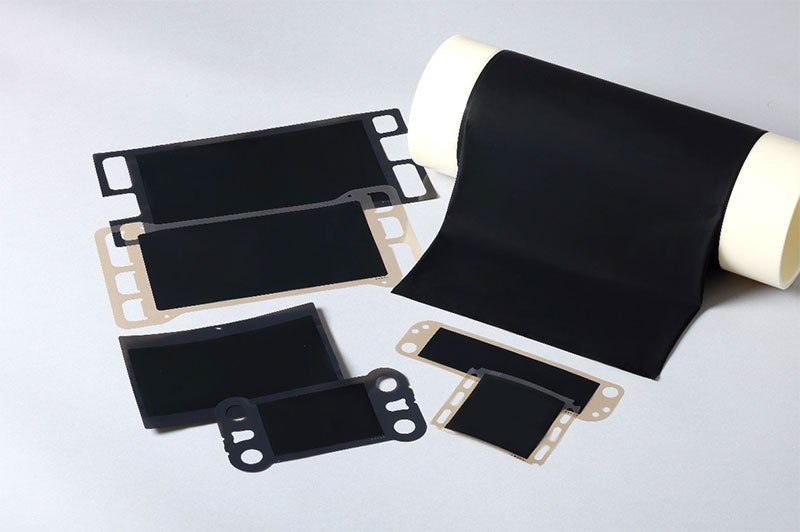
PEM fuel cells are powered by GORE® PRIMEA® Membrane Electrode Assemblies (MEAs).
An MEA consists of the GORE-SELECT® Membrane with Gore’s electrodes added on either side to support the electrochemical conversion of fuel to electrical energy.
Designed for both hydrogen or reformate fuel streams, MEAs made with Gore's proprietary membranes and novel electrode technologies can optimize the power density and durability of a system's design while allowing for more versatile packaging configurations to meet the most demanding application requirements.
See how our fuel cell products are driving change in the automotive industry.
GORE-SELECT® MEMBRANE LINE-UP
Gore offers a range of membrane products, each tailored to meet a specific performance requirement. Not all ePTFE-reinforced membranes are the same, and we understand the importance of selecting the right membrane to improve durability and offer optimized performance.
| Membrane Name | Lead Application / Market | Value |
|---|---|---|
| M735.18 | Automotive | Durable & low gas permeance |
| M740.18 | Stationary power generation (chemically demanding automotive) | High chemical durability & low gas permeance |
| M775.15 | Commercial vehicle and other heavy-duty applications | High chemical durability & high power density |
| M788.12 | Automotive, back-up power, range extender, fork-lift and portable | High chemical durability & low gas permeance & cost-effective |
| M765.08 | Passenger vehicle | High power density under dry condition & cost-effective |
GORE-SELECT® MEMBRANE KEY FEATURES
Four key features of our GORE-SELECT® Membranes address critical requirements of automotive fuel cell manufacturers.
High Proton Conductance & High Power Density
Thin films and superior water transport in GORE-SELECT Membranes enable low proton resistance and therefore high power density, which enables design flexibility for the fuel cell system and stack.
Enhanced Mechanical Durability
A GORE-SELECT Membrane remains dimensionally stable under repeated dry-wet cycles in rigorous mechanical tests.
Our highly-engineered technology minimizes the trade-off between performance and durability.
Improved Chemical Durability
Our advanced additive technology enables a long service life in harsh operating conditions. With this enhanced level of durability, engineers have the potential to push the limits of the hydrogen fuel stack even further.
Low Gas Permeance
Our innovations allow us to control the composition of our reinforced membrane, leading to a thinner design with a lower gas permeation rate than thicker, non-reinforced membranes.
GORE-SELECT® MEMBRANE ATTRIBUTES

Each GORE-SELECT Membrane achieves these key characteristics to varying degrees, according to operational requirements and customer-defined specifications. This allows us to offer solutions that are optimized for multiple industries and applications.
GORE’S TECHNOLOGY: EMPOWERING BETTER FUTURES, TOGETHER
We consult, create and collaborate closely with our customers to test and evaluate products, and have developed a deep understanding of how our components perform within hydrogen fuel cell systems.
This knowledge contributes significantly to our own research, development and manufacturing process, facilitating the production of advanced membrane technologies that are fit for use – and perform as promised.
With our deep experience and expertise in PEM design and materials technology, we understand the specific needs and requirements of various PEM fuel cell uses and applications.
From passenger vehicles and stationary power generation, to large-scale commercial and long-range transportation applications, to advanced mobility projects: fuel cell energy is the future, and we are committed to continuing to push boundaries towards it.
The Science Behind Gore's Innovations
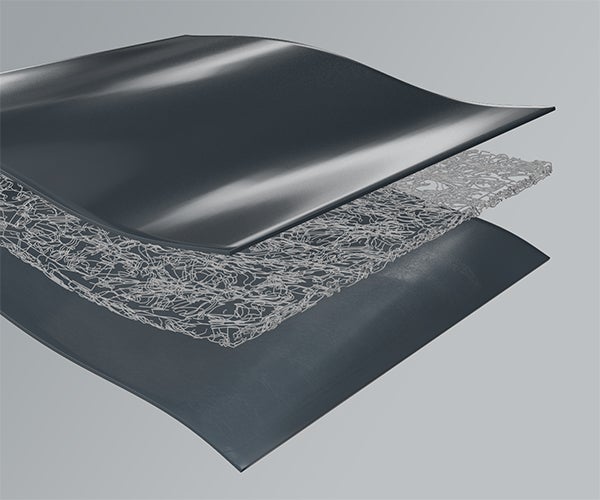
Gore's expanded polymer membrane technology, known for its durability and performance, was a breakthrough discovery by Bob Gore in 1969. Since then, Gore's continuous innovation has evolved into many innovative membrane technologies used in numerous industries. Discover how our advanced materials engineering expertise is helping to improve the lives of people around the world.
The Gore Advantage
RISING TO THE CHALLENGES OF FUEL CELL TECHNOLOGY
Hydrogen energy and fuel cell technology has endless potential – and exciting possibilities.
But the path to a carbon-neutral future is not without its obstacles.
Hydrogen energy is the key to achieving carbon neutrality. Fuel cell applications can decarbonize our cars, our cities, even entire industries. This sustainable, efficient technology will create countless jobs, unlock significant opportunities for various interest groups, and contribute to climate change solutions.
But to change the future, we need to start with the present.
Current commercial projects are demonstrating viable success. Public and private policy-making and investment are greatly increasing. A net-zero reality is within our reach.
However, to be truly competitive against conventional combustion energy, fuel cell technology must be more accessible, in greater volume, at high quality, and lower cost.
And that’s precisely our mission.
MAKING PROGRESS THROUGH PARTNERSHIPS

To achieve success in the new energy era, it pays to be in good company.
Fuel cell manufacturers are looking for companies with deep expertise in the relevant research and development areas.
An outstanding track record. A culture of innovation. Broad application and process knowledge to meet challenges and mitigate risks. The capacity to deliver a secure supply of high-quality products to lower system and operational costs.
In short, manufacturers looking to succeed in the hydrogen fuel cell market need more than a supplier.
They need a partner.
And that’s where Gore comes in.
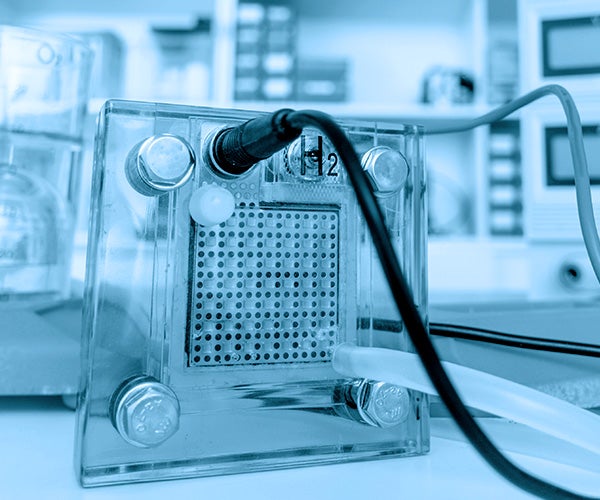
Harnessing Key vectors for optimal Fuel cell system performance
Choosing the right proton exchange membranes (PEMs) to meet customer requirements can be a challenge. We spoke with our product specialist Chow Mun Hoe about harnessing key vectors for optimal performance in fuel cell systems.
THE GORE ADVANTAGE
From research to raw materials, development to design and logistics, Gore provides services, solutions and support to fuel cell manufacturers across the world.
 |
"It is an honor to have the opportunity to collaborate with our customers and the industry to bring clean energy solutions to the world. Gore is privileged to be able to help our customers accelerate the scaling of the hydrogen market by enabling technical and economic performance advancements." Nathan Ross, Gore Alternative Energy & Storage Global Sales Leader |
Gore's technologically advanced portfolio of proton exchange membranes (PEMs), combined with its ability to quickly and efficiently optimize commercialization while lowering total cost of ownership is critical in today's fuel cell industry.
Continuous Innovation
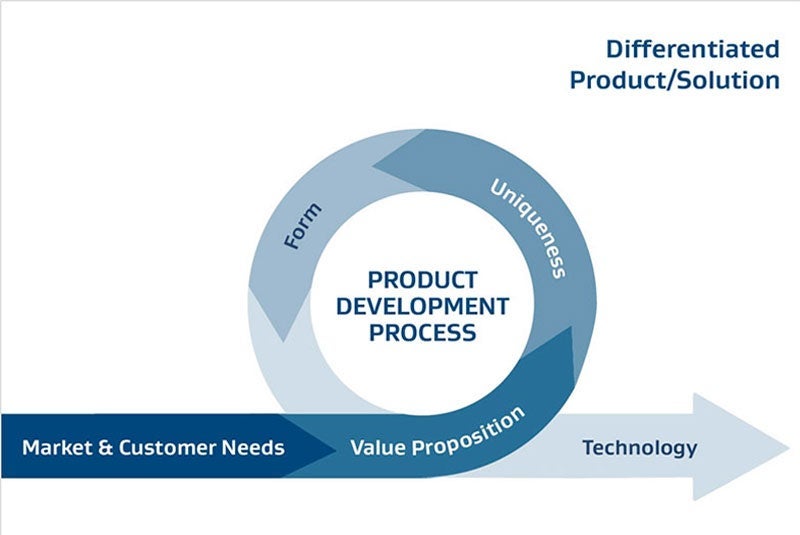
For hydrogen fuel cells to be a truly feasible alternative to fossil fuel powertrain solutions (and other modern alternative low-carbon options), product and process innovation is essential.
From characterization and analysis techniques to membrane and catalyst structure, hydrogen fuel cell design and development must continuously evolve to meet the needs of the market and the manufacturer.
We are committed to ongoing, disciplined innovation through an iterative, agile product development process that considers multiple product and market factors. This approach enables us to deliver high-performance hydrogen fuel cell solutions to fulfill the rapidly growing demand for commercial applications.
Technical Service & Support
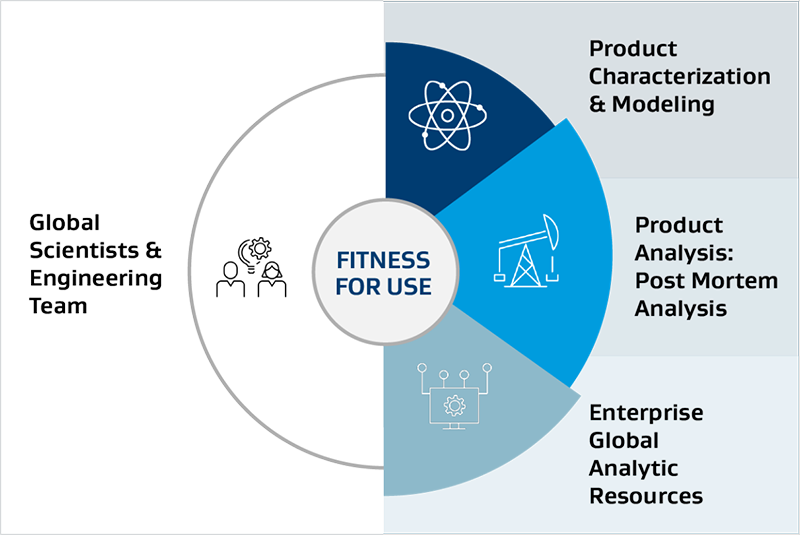
Fuel cell engineers and stack designers are faced with the challenge of finding a supplier who can rapidly and proactively provide fit-for-purpose solutions. In this nascent industry, manufacturers struggle to find sufficient technical service and support for their R&D objectives and process development.
At Gore, we know the materials. We know the market. We’ve been championing deep science for decades.
Our thought leadership, industry experience and enterprise-wide analytical resources are the strong foundations of a product development process that gives our customers unparalleled technical insights – and ultimately accelerate their time to market.
Lowering Total Cost of Ownership

Achieving cost parity with conventional fuel solutions is a critical factor to fuel cell commercialization. While progress is being made, hydrogen fuel cell technologies have not yet achieved the economy of scale to be cost-competitive with traditional combustion engines. Manufacturers also need to mitigate their investment risk by reducing production costs.
The properties of GORE-SELECT Membranes not only improve system reliability, but enable the lowest cost of proton exchange membrane (PEM) fuel cell system design in multiple ways.
Thinner membranes with higher power density enable OEMs to reduce the size of a fuel cell stack and additional expensive components. Our reinforcement technology allows fuel cells to operate in higher temperatures and lower humidity, simplifying internal heating and humidifier requirements.
Gore can produce high volumes of thinner PEM at a faster rate, reducing the cost of manufacturing and additional raw materials to OEMs.
By offering improved durability and therefore a longer fuel cell stack life, a GORE-SELECT Membrane also reduces the total cost of a system over its lifetime.
Supply Security

When competing in a developing commercial market, there is little margin for error.
When that industry has profound implications for the future of our planet, there is even less.
As hydrogen and fuel cell technologies move towards mass-market applications, the ability to scale high-performance PEM at higher volume, lower cost, and minimal risk is vital.
Countries across the world are developing a significant interest in hydrogen fuel cell technology – to the point of national investment policies. A reliable supply chain is crucial to source hydrogen fuel cell raw materials and components to produce and supply high-quality PEM in sufficient quantities to meet emerging demand.
We’ve been in the fuel cell business since 1994 and led from the front in handling hydrogen fuel cell materials since then. Our process consistency – demonstrated in our production data – has delivered a uniform product that greatly reduces the risk of random failure, low process yields, and quality defects.
As one of the most experienced manufacturers of fuel cell components in the industry today, our global network can assure supply security, process stability and quality consistency – on a massive scale.
Quality Consistency at High Level
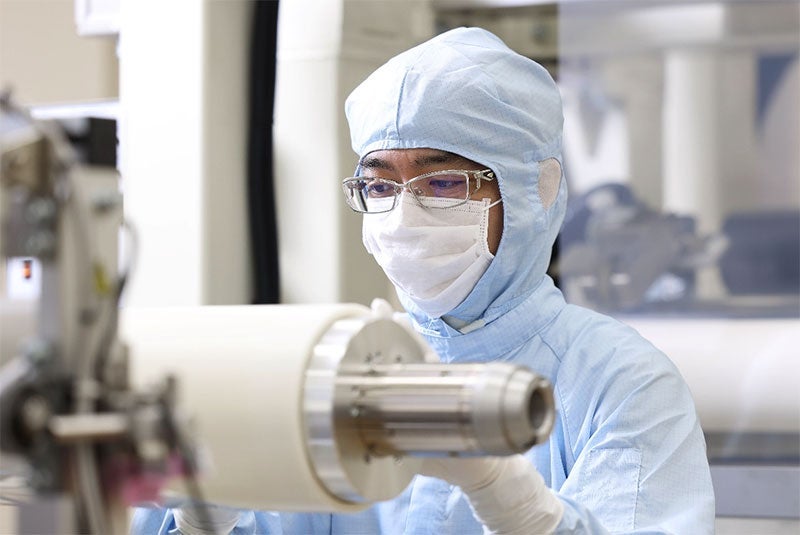
As well as lowering cost, improving the durability of fuel cell technology is another essential consideration in ensuring its commercial viability.
Gore’s unique PEM design sets new standards for both power density and membrane durability, yielding high performance over a longer life cycle – giving manufacturers the freedom to push the boundaries of hydrogen fuel cell design.
Our expertise in precise coating technology enables minimal cell-to-cell variability, producing high product uniformity and quality. It gives fuel cell stack makers holistic control of overflow and heat distribution, ensuring stack performance consistency and a longer-lasting lifespan.
Our fuel cell manufacturing facilities have undergone audits for quality management and environmental management systems and have been certified ISO 9001 and ISO 14001. Certification for IATF 16949 is under way.
Recent process development efforts have enabled the rapid production of GORE-SELECT® Membranes with greater width and higher uniformity. Gore can meet OEM quality requirements and deliver high-volume supply through our process stability and capability.
GORE’S SUSTAINABILITY COMMITMENTS
As a company and as individuals, we are committed to achieving a positive economic and societal impact while being environmentally responsible.
This focus on sustainability is directly aligned with our promise of Together, improving life, and our long-established values, culture and commitment to our Associates, customers and communities.
Our History
GORE’S FUEL CELL HISTORY: LEADING THE WAY FOR OVER 25 YEARS
Millions of square meters of PEM and MEA manufactured for more than 60,000 fuel cell vehicles. More than 100 different models developed. Over 200,000 metric tons of CO2 emissions reduced.
Our Fuel Cell Business Unit was established in 1995. Since then, we have partnered with nearly all of the major fuel cell system developers and OEMs worldwide.
Ever since the launch of GORE PRIMEA® membrane electrode assembly (MEA) – the first commercially available MEAs in the world – Gore has been leading the global PEM market.
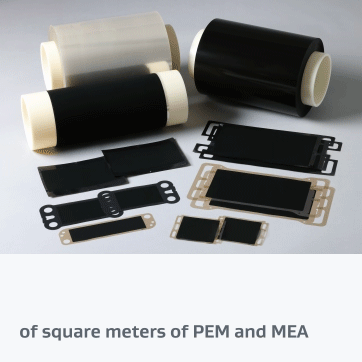
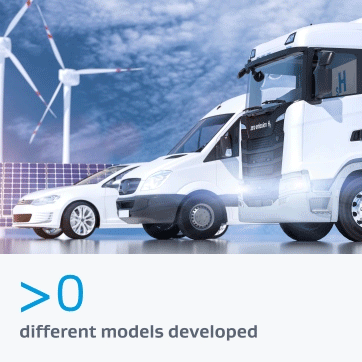
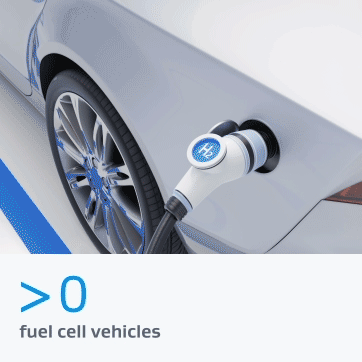
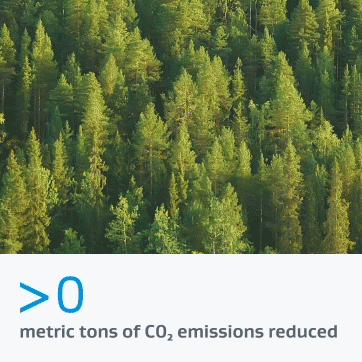
Our unique technologies are powering a wide variety of applications, from passenger and commercial vehicles to heavy industry and materials handling, as well as stationary, back-up and portable power generation.
And as the world wakes up to the potential of hydrogen fuel cell energy to power a cleaner future – we feel like we’re just getting started.
Gore’s material innovation transforming people’s lives

Gore’s deep understanding of expanded polymer membrane technology has significantly impacted humanity in various industries, including healthcare, mobility, and clean energy. Learn how a single material can transform lives, electrify the world, and make it more sustainable in a conversation with Enze Chen, our global strategic marketer for alternative energy and storage.
OUR FUEL CELL JOURNEY
We entered the fuel cell industry over 20 years ago. From new products to new partnerships, we’re immensely proud of the progress we’ve made – and the path we’re moving on.
Some high-performance highlights include:
1994
Gore begins to characterize its newly developed ionomer composite membranes for various applications, including fuel cells, enabling a very high-density operation.
1995
● PEM Fuel Cell business unit established
● Bahar patent first filed patenting Gore’s ePTFE reinforced PEM technology
● 5000 Series MEA introduced, based on GORE-SELECT® Membrane composite
1997
5510 Series (2nd generation) MEA introduced, becoming the industry standard for high performance MEAs for the next five years.
1999
Gore commissions a high-volume MEA manufacturing line with over 100,000 square meters of MEA capacity in its Maryland plant.
2000
Gore develops the capability to design and manufacture novel, high-performance fluro-ionomers at the Gore facility in China.
2002
● GORE® PRIMEA® Series 56 MEAs for stationary PEM fuel cells are made available commercially, with an unprecedented combination of durability and power density, demonstrating over 26,000hrs of continuous operation.
● H Power Corp., a leading fuel cell manufacturer, selects Gore to supply MEAs for its commercial PEM fuel cell applications
2003
● GORE® PRIMEA® Series 57 MEAs for transportation make their commercial debut (with lifetimes 4x longer than previous industry standard)
● GORE® PRIMEA® Series 58 MEAs for backup and portable fuel cells hit the market, delivering high power density under dry conditions
● 1st mass production line for PEM launched in Japan
● Hydrogenics Corporation, a leading clean power generation company, selects Gore’s MEAs to power the 50kw HyStat™ fuel cell stationary power generator
2005
Gore demonstrates 10-fold MEA lifetime improvement in accelerated testing
2006
Gore broadens its MEA product portfolio to include new GORE® PRIMEA® Membrane Electrode Assemblies series, enabling commercialization for backup power, materials handling, bus, stationary cogeneration and developmental automotive applications.
2010
Nihon Gore (Gore Japan) is acquired to create a fully integrated fuel cell solutions business
2014
GORE-SELECT® Membranes facilitate the fuel cell stack in the groundbreaking Toyota Mirai fuel cell vehicle (FCV).
2016
GORE-SELECT® Membranes are applied in the innovative Honda Clarity FCV, the first fuel cell sedan that provides cabin space for five passengers.
2018
GORE-SELECT® Membranes contribute to the fuel cell stack in Hyundai’s hydrogen-powered NEXO Fuel Cell EV SUV.
2019
● Gore's fuel cell technology supports Panasonic's 6th generation household fuel cell cogeneration system
● Gore unveils new grade, M788, at The International Hydrogen Fuel Cell Vehicle Congress 2019 in China
2020 - Future
Gore installs larger PEM manufacturing capacity to become the leading global supplier.

Our commitment to innovation has only gotten stronger since Bob Gore made his pioneering discovery of ePTFE over 50 years ago.
As we continue to break new ground and push new boundaries in the hydrogen energy industry, leading the way into a better future, we are always mindful of - and motivated by - our promise: Empowering better futures, together
Read more about the unique design of our fuel cell technologies here.
Industry Insights
HYDROGEN FUEL CELLS: POWERING TOMORROW
Hydrogen fuel cells hold the power - quite literally - to an energy solution that doesn’t cost the earth.
Highly efficient, with zero emissions. Robust, reliable, scalable and sustainable.
Hydrogen energy is a viable low-carbon solution today – and a green energy power source for the future.
With more than $500 billion in global investment and 66 countries committing to sustainable energy transition, the world will reduce its carbon dioxide emissions by 60% by 2050. By then, hydrogen will fuel 18% of global energy demand, with applications across electric grids, industrial, heating and transportation1.
From electric vehicles to industrial power supplies, commercial buildings to cargo ships, hydrogen fuel cell technology is the alternative energy solution that can turn our net-zero vision into reality.
And it’s our mission to make that happen even sooner.
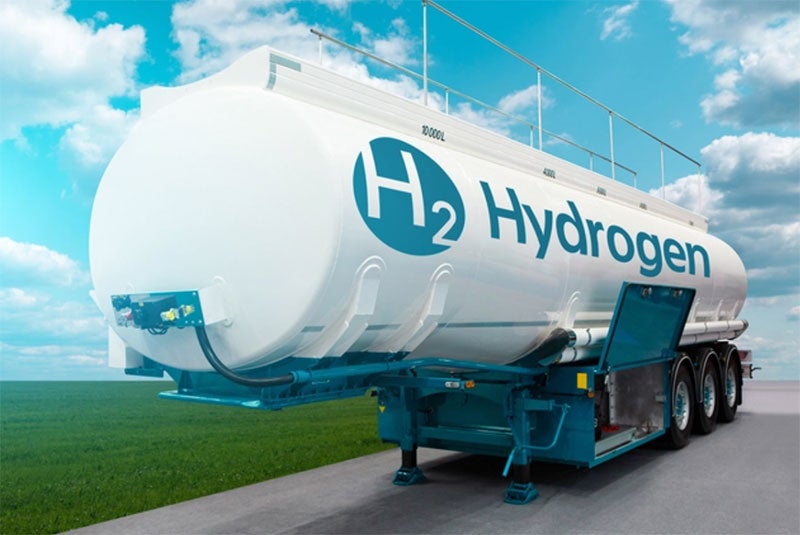
Gore supplies a technologically advanced portfolio of proton exchange membrane (PEM) and membrane electrode assemblies (MEAs) for the global hydrogen fuel cell industry. Our PEM supply is fully integrated into the commercial production of major fuel cell vehicle manufacturers across the world.
With the driving range and refill time of a fuel cell vehicle similar to internal combustion vehicles, fuel cell vehicles are fast becoming attractive options in the transportation market. In fact, it is estimatedthat between 2025 and 2030, the automotive industry globally could produce as many as 500,000 fuel cell vehicles per year2.
And we are very excited to play our part.
Read the latest fuel cell news here.
1 ‘Fostering Effective Energy Transition’, World Economic Forum 2021 Report
2 ‘Future Prospects of Fuel Cell-related Technologies and Market’, Fuji Keizai, February 2, 2015.
THE BENEFITS OF HYDROGEN FUEL CELLS
As the key to hydrogen electric conversion, hydrogen fuel cell technology is an essential factor in the global transition towards clean energy. This modern technology offers several advantages over traditional power generation:
Greater Efficiency, Zero Emissions

The biggest advantage of hydrogen fuel cells, and their relevance to a net-zero future, is that they only produce water and heat as byproducts when generating electricity. The complete absence of carbon means that carbon dioxide and carbon monoxide, both harmful greenhouse gas emissions, are not produced.
In fact, the emissions are so clean that they are literally consumable. NASA has used fuel cell technology for years to power space shuttles, with the water emissions siphoned to the crew as drinking water!
Generating electricity through chemistry, not combustion, also makes for an immensely more efficient power system than traditional methods such as turbines or gasoline engines. Fuel cells run between 40-60% efficiency, compared to internal combustion engines at around 25% and power plants at 35%.
Energy Security & Fuel Flexibility

Because hydrogen fuel generation does not rely on traditional fossil fuels such as oil for energy production through combustion, economic dependence on conventional fuel imports is reduced - improving energy security for the hydrogen fuel producer.
Hydrogen can be produced anywhere with available water and a power source, independent of external conditions that cannot be controlled - unlike, for example, solar and wind power (which are reliant on their local environment and climate). This further decreases the need for energy imports while boosting job creation and local industry growth.
Scalability

Individual fuel cells can be joined with one another to form ‘stacks’ which can be combined into larger systems. From electric vehicles to energy systems for the entire home, to multi-megawatt installations providing electricity to the grid, hydrogen fuel cells can be scaled for a huge range of commercial applications.
Renewability & Reliability

With fewer moving parts in the system, hydrogen fuel cells are easier to maintain compared to traditional combustion engines. Plus, their high energy density means longer operation times with less frequent refueling.
There are many ways to produce pure hydrogen, from conventional fuels to biomass. If hydrogen is generated through a renewable source, such as wind or solar power, then hydrogen fuel cells can be considered a renewable energy source in turn.
Quiet Operation

Fewer moving parts also means a near-silent operation, which makes fuel cells ideal for many residential and commercial applications, such as hospitals. Less noise pollution is a welcome benefit in developed urban areas – as well as a major advantage in military application.
Hydrogen energy has the potential to decarbonize entire systems, cities and industries.
Latest Fuel Cell Energy News
As a global leader in the fuel cell industry, Gore is often in the spotlight - and the headlines. Read our recent press releases, company announcements, and more of the latest hydrogen energy news here.
Join Gore at the Hydrogen Online Conference 2021October 7, 2021 - October 8, 2021 This 24-hour event features more than 30 speakers and more than 100 exhibitors — all presenting leading-edge information and technologies to hydrogen and clean-energy professionals globally! |
Ballard And Gore Team Up To Advance Fuel Cell GrowthPosted June 9, 2021 A multi-year fuel cell supply agreement was announced today between Ballard Power Systems and W. L. Gore & Associates. A signing ceremony at the 6th International Hydrogen Fuel Cell Vehicle Congress (FCVC 2021) honored the two companies’ prior collaborations and supply partnerships. |
GORE-SELECT® Membrane Honored by ToyotaPosted March 18, 2021 W. L. Gore & Associates announced that its GORE-SELECT® Membrane received Toyota Motor Corporation’s prestigious Project Award in the Technology Section. GORE-SELECT® Membrane was selected for its innovative technology, which contributes to the performance and value of the new MIRAI, Toyota’s premium fuel-cell electric vehicle introduced in December 2020. |
Gore's Membrane Technology Enables Toyota's Second-Generation Fuel Cell VehiclePosted December 10, 2020 W. L. Gore & Associates has announced that GORE-SELECT® Membrane has been selected to be incorporated into the new Toyota MIRAI. The new MIRAI, Toyota’s second-generation fuel cell vehicle, is powered by a fuel cell stack with new GORE-SELECT Membrane featuring superior performance and durability. |

